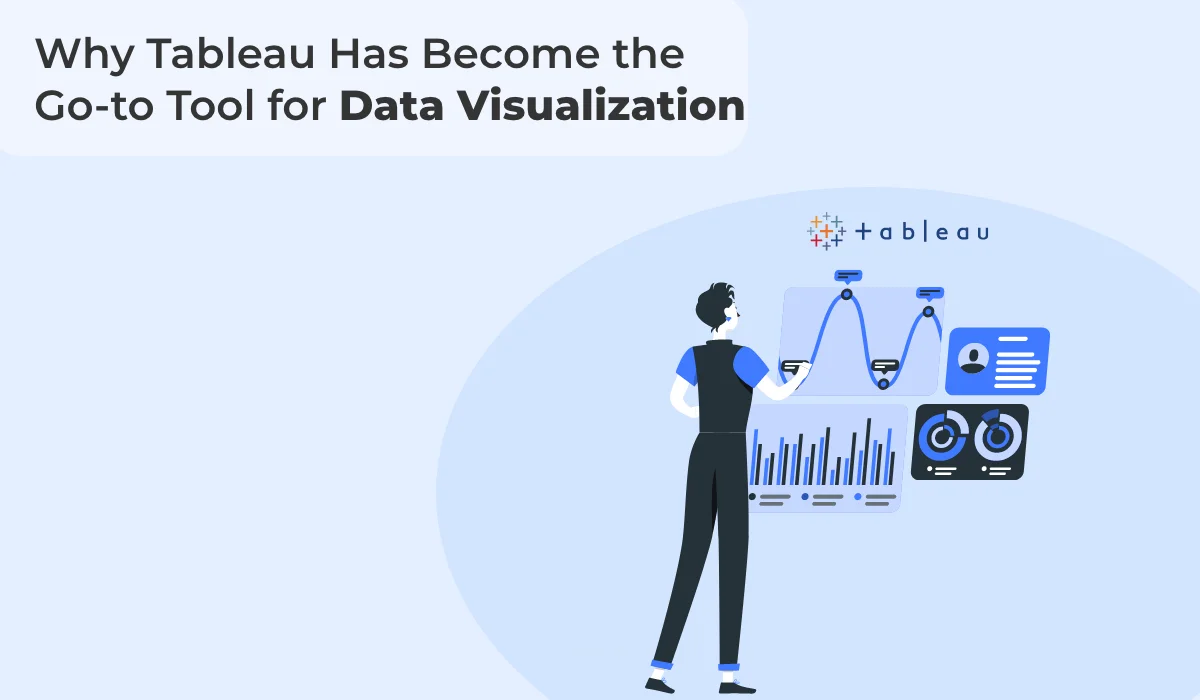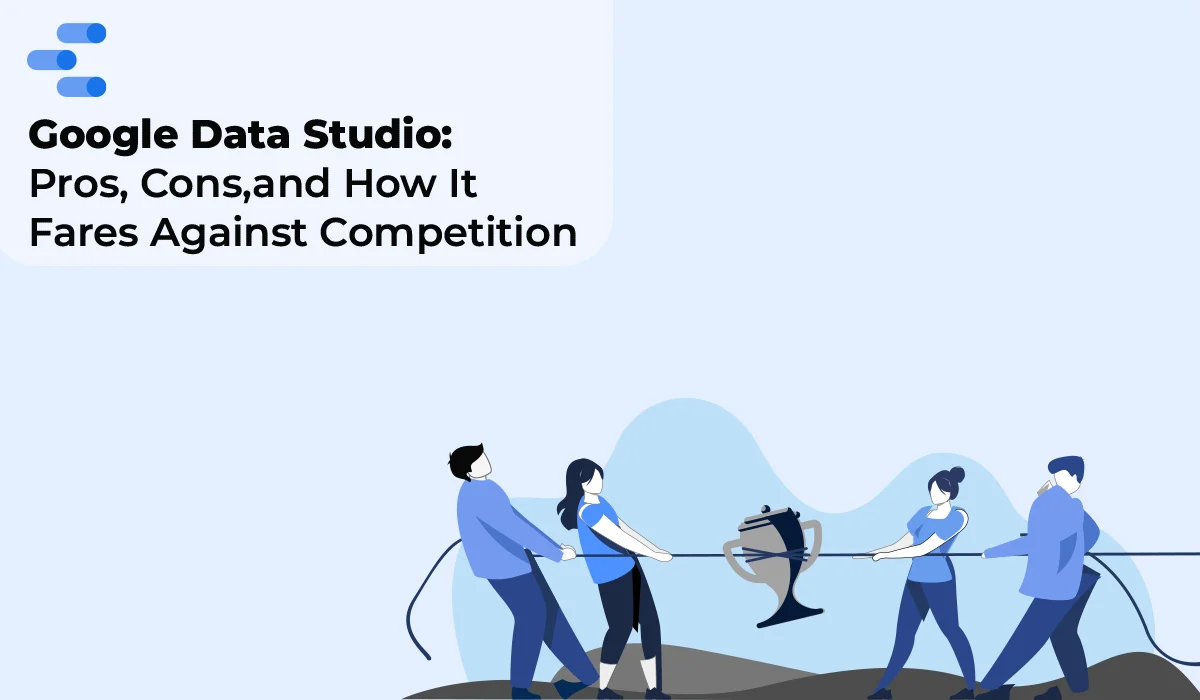Why Tableau Has Become the Go-to Tool for Data Visualization

Published on: March 2, 2022
Updated on: November 13, 2024
1765 Views
- Data Visualization
8 min read
Is your business making meaning out of data?
In a connected and data-driven world, businesses are continuously competing with each other. Irrespective of the size and scale of their operations, organizations are increasingly embarking on data transformation. Data visualization is gaining increasing importance and has been valued at $2.99 billion and is expected to reach $5.17 billion by 2026.
From product development to marketing and sales, every aspect of a business is data-driven today. With AI and Big Data taking the center stage, the importance of data is likely to further grow in the future. Only if your business can make meaning out of data and make informed decisions, will you be in command of your business.
Data in its true form is facts and statistics, and it is either used for recording business activities or measuring the performance of a business or both in many cases.
However, raw data by itself is not always informative. This is where data visualization comes into the picture; it converts raw data into meaningful insights. Data visualization is the process of converting data into visual elements such as charts, graphs, and maps and is used to analyze data more holistically and gain deeper insights.
Several tools let you analyze data and make meaning out of it. Google Data Studio, Tableau, and Power BI are among the leading tools used for this purpose.
Tableau has been the leader in this territory and commands a lion’s share of the market. It has topped the table for nine consecutive years in the Gartner Magic Quadrant for Analytics and Business Intelligence Platforms and powers the biggest of organizations in the world.
Curious what makes it top the charts? In this blog post, we shall look at reasons why Tableau has become the go-to tool for data visualization.
What Is Tableau?
Tableau is a data visualization tool that is primarily used for business intelligence and data analysis. The primary focus of this tool is to help users “see and understand data.” Tableau helps solve core business problems and therefore, businesses of all sizes across industries have immensely benefited from using this tool.
11 Important Features of Tableau
Tableau is a feature-rich data visualization tool and some of its features over the other have earned it a loyal clientele over time:
1. Powerful Dashboard
It has a powerful dashboard offering a comprehensive view of your data. From texts to numbers and visual objects, you will be able to exhibit data in the form of visual narratives of the trends. There are multiple layouts and formats to choose from and filters that let you deploy data in a tailored way on the dashboard. Tableau lets users copy elements or the entire dashboard to different workbooks.
2. Sharing and Collaboration
Tableau makes it easy for different teams to share and collaborate. You can securely share data on the cloud, on-premises, or in a hybrid environment. This speeds up reporting and data visualization, allowing decision-makers in organizations to respond quickly to emerging opportunities or threats.
3. Data Source Support
You can fetch data on Tableau from multiple data sources, be it spreadsheets, on-cloud data, relational databases, or big data. The data sources that Tableau supports range from Google Sheets, Salesforce, MemSQL, and Google Analytics, to Amazon Athena, SQL Server, and Dropbox.
4. Advanced Visualization
Visualization is the greatest USP of Tableau. Users get multiple options to visualize data and create reports such as bar charts, histograms, density maps, bubble charts, line charts, scatter plots, treemaps, bullet charts, and pie charts; the list never ends.
5. Full-Proof Security
The security of your business data is non-negotiable. Tableau has built a fool-proof security system with multiple authentication steps to prevent unauthorized access to business data. The advanced permission system can be tailored to meet the niche needs of your business and make data connections safer. You can easily integrate it with third-party security protocols such as Kerberos and Active Directory.
6. Trend Lines
Tableau is great for predictive analysis, thanks to the Trend Lines feature. It is meant to predict the continuation of a certain variable and identify the correlation between different variables in data. This feature offers users insightful data predictions and can be used to predict things such as sales forecasts.
7. Ask Data
With this feature, your team can play with data. Type in a query in natural language as you do for a Google search and Tableau will immediately return relevant answers. These answers come in the form of visuals that you can immediately add to your reports to make them more meaningful.
8. Tableau Exchange
This is a one-stop-shop for adding new features and functionalities to the dashboard. It helps users enhance data visualization by adding dashboard extensions, accelerators, and connectors to databases and applications. Tableau Exchange allows businesses to jumpstart data visualization and analysis without prior expertise in this field.
9. Mobile Viewing
Smartphones and tablets have become the go-to devices for most business executives in a BYOD world. Dashboards and reports created in Tableau are fully compatible with mobile. The tool also allows users to build tailored mobile layouts to the dashboard specific to different mobile devices. Users can handle data seamlessly on mobile devices irrespective of the screen size.
10. In-Memory and Live Data
Tableau lets you connect seamlessly to live data sources apart from integrating in-memory data into your reports. Once a live data source is connected to the dashboard, it automatically updates and refreshes the reports and data visualizations whenever there is a change in the data source.
11. Replay Animations
Tableau combines data visualizations with advanced animations to present a holistic view of the data and help users gather intelligence. You can play these animations with the click of a button and present data trends, understand the change in trends, and interpret data to make quick comparisons between different values.
Reasons That Make Tableau A Market Leader in Business Intelligence Industry
Data visualization and business intelligence are competitive territories and there is no dearth of tools for these. However, Tableau has more than two times the market share of its nearest competitor Power BI. With the likes of LinkedIn, Verizon, Lufthansa, Siemens, and Honeywell among its customers, Tableau has left the competition far behind. Let us take you through the reasons that make Tableau the market leader in the business intelligence world.
1. Quality of Visualization
Tableau takes visualization to the next level and lets users create beautiful reports that offer meaningful insights into the data in an interactive way. When compared to other tools, Tableau allows you to create interactive visualizations in seconds with an easy-to-use drag and drop feature. It can perform complex tasks easily and lets users explore different sets of data.
2. No Coding Skills Needed
It has an intuitive user interface and does not require data analysts to have coding skills. The drag-and-drop interface allows anybody to build data visualizations from scratch. The low-entry barriers let users perform advanced analytics with ease.
3. Multiple Data Sources Support
Tableau allows you to connect to different data sources including cloud and live data sources. This is one of the reasons it stands ahead of the crowd and enjoys patronage among businesses.
4. Big Data Handling
Whether you have a hundred columns of data or are looking to analyze the sales performance of your team for the last decade, Tableau is the perfect tool. It can handle enormous volumes of data without any significant change in performance.
5. Refinement
BI tools take time to mature in terms of refinement of their features. Tableau has been in this market for more than a decade and the tool has undergone constant development and refinement. It has grown with the changes in user requirements and the complexity of data analysis. It receives regular updates and introduces new features in the market for others to follow.
Final Thoughts
There is no doubt that data holds great importance for your business, and therefore, Tableau is an ideal tool for you. Its ease of use and advanced features make it the go-to tool for business intelligence and data visualization. Using this tool, your business will gain crucial insights from raw data and create interactive visualizations easily. Tableau empowers organizations and democratizes data insights.
If you haven’t tried your hands at Tableau yet, Tableau Public offers you a sneak peek into millions of free visualizations. This open data is made available for learning and sharing and gives you insights into the true potential of the tool. Explore it and you will understand the true power of data.
If you are in search of a team that has dedicated data scientists who can help your organization with interactive dashboards and create insightful reports, Growth Natives is here to help you. Our team will work closely with your organization to help make informed and meaningful decisions with data visualization. For more information on our services or to get started with your project, visit our website or drop us an email at info@growthnatives.com.
Frequently Asked Questions
Tableau has become popular for data visualization due to its user-friendly interface, robust features, ability to handle large datasets, diverse visualization options, and seamless integration with different data sources.
Tableau stands out from other data visualization tools due to its intuitive drag-and-drop interface, real-time data analysis capabilities, interactive visualizations, and wide range of customization options.
Tableau helps businesses make better decisions by enabling users to visualize and analyze data in meaningful ways, identify trends and patterns, uncover insights, and communicate findings effectively to stakeholders.
Tableau allows users to create interactive dashboards and reports by enabling them to visualize data in various formats (such as charts, graphs, maps, and tables), add interactivity through filters and parameters, and customize the appearance and layout of the dashboard to meet their specific needs.
Yes, Tableau is designed to handle large and complex datasets efficiently, thanks to its in-memory data engine and optimization techniques. Users can connect Tableau to a wide range of data sources, including databases, spreadsheets, cloud services, and big data platforms.



